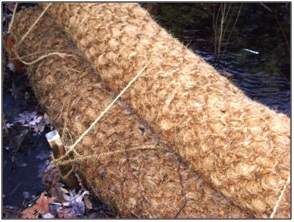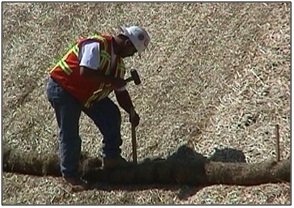Fiber Rolls

Description
Fiber rolls (also called fiber logs or straw wattles) are tube-shaped erosion-control devices filled with straw, flax, rice, coconut fiber material, or composted material. Each roll is wrapped with UV-degradable polypropylene netting for longevity or with 100 percent biodegradable materials like burlap, jute, or coir. Fiber rolls complement permanent best management practices used for source control and revegetation. When installed in combination with straw mulch, erosion control blankets, hydraulic mulches, or bounded fiber matrices for slope stabilization, these devices reduce the effects of long or steep slopes (Earth Saver Erosion Control Products, 2005). Fiber rolls also help to slow, filter, and spread overland flows. This helps to prevent erosion and minimizes rill and gully development. Fiber rolls also help reduce sediment loads to receiving waters by filtering runoff and capturing sediments.
Applicability
Fiber rolls can be used in areas of low shear stress. Avoid using them in channels that are actively incising or in reaches with large debris loads or potential for significant ice buildup (Maryland Department of the Environment, 2000). Fiber rolls have been used to control erosion in a variety of areas--along highways and at construction sites, golf courses, ski areas, vineyards, and reclaimed mines. According to the California Stormwater Quality Association (CASQA, 2003), fiber rolls can be suitable in the following settings:
- Along the toe, top, face, and at-grade breaks of exposed and erodible slopes to shorten slope length and spread runoff as sheet flow
- At the end of a downward slope where it transitions to a steeper slope
- Along the perimeter of a project
- As check dams in unlined ditches
- Downslope of exposed soil areas
- Around temporary stockpiles

Siting and Design Considerations
Fiber rolls should be prefabricated rolls or rolled tubes of geotextiles fabric. When rolling the tubes, make sure each tube is at least 8 inches in diameter. Bind the rolls at each end and every 4 feet along the length of the roll with jute-type twine (California Stormwater Quality Association, 2003).
Sloped ground applications
On slopes, install fiber rolls along the contour with a slight downward angle at the end of each row to prevent ponding at the midsection (California Straw Works, 2005). Turn the ends of each fiber roll upslope to prevent runoff from flowing around the roll. Install fiber rolls in shallow trenches dug 3 to 5 inches deep for soft, loamy soils and 2 to 3 inches deep for hard, rocky soils. Determine the vertical spacing for slope installations on the basis of the slope gradient and soil type. According to California Straw Works (2005), a good rule of thumb is:
- 1:1 slopes = 10 feet apart
- 2:1 slopes = 20 feet apart
- 3:1 slopes = 30 feet apart
- 4:1 slopes = 40 feet apart
For soft, loamy soils, place the rows closer together. For hard, rocky soils, place the rows farther apart. Stake fiber rolls securely into the ground and orient them perpendicular to the slope. Biodegradable wood stakes or willow cuttings are recommended. Drive the stakes through the middle of the fiber roll and deep enough into the ground to anchor the roll in place. About 3 to 5 inches of the stake should stick out above the roll, and the stakes should be spaced 3 to 4 feet apart. A 24-inch stake is recommended for use on soft, loamy soils. An 18-inch stake is recommended for use on hard, rocky soils.
Projects without slopes
Fiber rolls can also be used at projects with minimal slopes. Typically, the rolls are installed along sidewalks, on the bare lot side, to keep sediment from washing onto sidewalks and streets and into gutters and storm drains. For installations along sidewalks and behind street curbs, it might not be necessary to stake the fiber rolls, but trenches must still be dug. Fiber rolls placed around storm drains and inlets must be staked into the ground. These rolls should direct the flow of runoff toward a designated drainage area. Place them 1 to 1½ feet back from the storm drain or inlet.
Limitations
The installation and overall performance of fiber rolls have several limitations, including the following (California Stormwater Quality Association, 2003):
- Fiber rolls are not effective unless trenched.
- Fiber rolls can be difficult to move once saturated.
- To be effective, fiber rolls at the toe of slopes greater than 5:1 must be at least 20 inches in diameter. An equivalent installation, such as stacked smaller-diameter fiber rolls, can be used to achieve a similar level of protection.
- If not properly staked and entrenched, fiber rolls can be transported by high flows.
- Fiber rolls have a very limited sediment capture zone.
- Fiber rolls should not be used on slopes subject to creep, slumping, or landslide.
Maintenance Considerations
The maintenance requirements of fiber rolls are minimal, but short-term inspection is recommended to ensure that the rolls remain firmly anchored in place and are not crushed or damaged by equipment traffic (Murphy and Dreher, 1996). Monitor fiber rolls daily during prolonged rain events. Repair or replace split, torn, unraveled, or slumping fiber rolls. Fiber rolls are typically left in place on slopes. If they are removed, collect and dispose of the accumulated sediment. Fill and compact holes, trenches, depressions, or any other ground disturbance to blend with the surrounding landscape.
Effectiveness
Unlike other BMPs that could cause water to back up and flow around the edges, fiber rolls allow water to flow through while capturing runoff sediments. Fiber rolls placed along the shorelines of lakes and ponds provide immediate protection by dissipating the erosive force of small waves. As an alternative to silt fences, fiber rolls have some distinct advantages, including the following (Earth Saver, 2005):
- They install more easily, particularly in shallow soils and rocky material.
- They are more adaptable to slope applications and contour installations than other erosion and sediment control practices.
- They are readily molded to fit the bank line.
- They blend in with the landscape and are less obtrusive than other erosion and sediment controls such as silt fence.
- They do not obstruct hydraulic mulch and seed applications.
- They can be removed or left in place after vegetation is established.
Fiber rolls can provide slope protection for 3 to 5 years (California Straw Works, 2005). They slowly decompose into mulch, and the netting breaks down into small pieces. The San Diego State University Soil Erosion Research Laboratory reported that the use of fiber roll products reduced offsite sediment delivery by 58 percent (International Erosion Control Association, 2005).
The Flint Creek watershed, which covers approximately 28 square miles of Lake and Cook counties in northeastern Illinois, was listed in the Illinois Water Quality Report (1994-1995) as being impaired due to nonpoint source pollution from land development, channelization, and urban runoff. Along with other bioengineering techniques, fiber rolls were installed along the shorelines of the creek to reduce the effects of wave action. Native plants were installed in the fiber rolls. As a result, the growth of vegetative cover increased and helped to stabilize the slopes along the banks of the creek. Ultimately, the water quality of Flint Creek was improved (USEPA, 2002).
Cost Considerations
Material costs for fiber rolls vary based on length, diameter and material type.
Labor hours should also be allocated for installation, monitoring, and maintenance. Because fiber rolls are usually left along slopes and are biodegradable, labor costs for removing them are avoided. However, sediment removal and disposal are still necessary in areas where sediment accumulates to at least one-half the distance between the top of the fiber roll and the ground surface.
References
CASQA (California Stormwater Quality Association). 2003.
California Stormwater BMP Handbook. (
http://www.cabmphandbooks.com/Documents/Construction/SE-5.pdf (4 pp, 115K,
About PDF) ). Accessed May 19, 2005.
California Straw Works. 2005.
Straw Wattles. (
http://www.publicworks.com/doc.mvc/Straw-Wattles-0001 ). Accessed May 19, 2005.
Earth Saver Erosion Control Products. 2005.
Rice Straw Wattles. (
http://www.earth-savers.com/ProductsAndSpecs.html ). Accessed November 28, 2012.
Maryland Department of the Environment. 2011.
Slope Protection and Stabilization Techniques. (
http://www.mde.maryland.gov/programs/Water/StormwaterManagementProgram/SoilErosionandSedimentControl/Pages/2011_ESC_details.aspx ). Accessed July 12, 2012.
Murphy, M., and D. Dreher. 1996. Northeastern Illinois Planning Commission, Chicago.
LakeNotes: Shoreline Stabilization Bioengineering Alternatives. (
http://www.lakespringfield.org/files/shoreline_stabilization.pdf (4 pp, 228K,
About PDF) ).
USEPA (U.S. Environmental Protection Agency). 2002.
Restoration of the Flint Creek Watershed: Restoration Partnership Completes Multiple Projects. Section 319 Success Stories, Vol. III. (
http://www.epa.gov/nps/Section319III/IL.htm ). Accessed May 20, 2005.